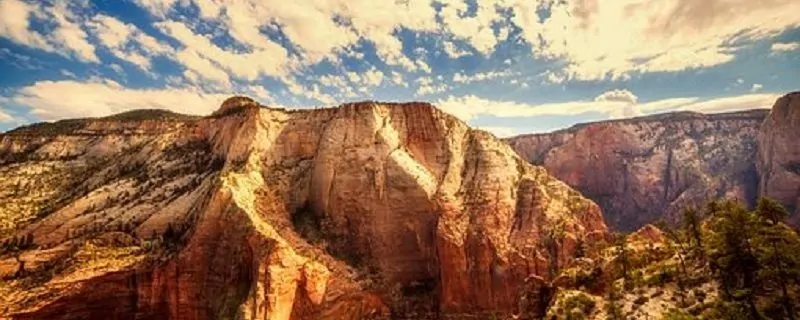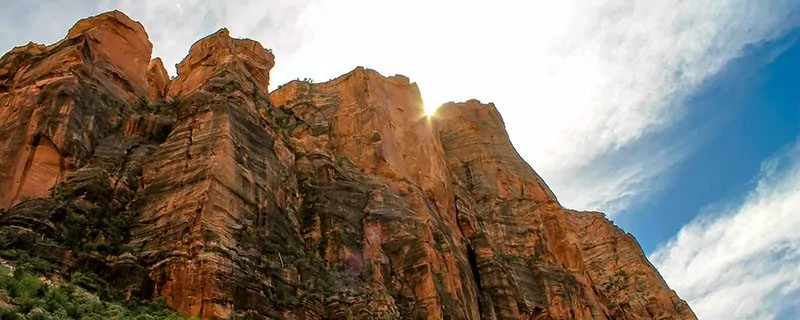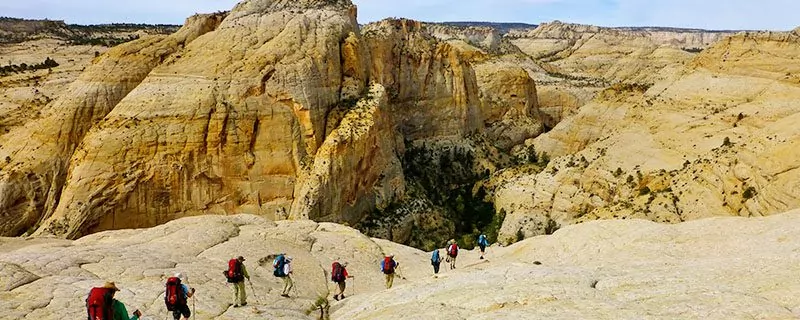Observation Point Trail
General Description
The hiking trail to Observation Point is one of the most challenging and rewarding day hikes in Zion National Park. At 8 miles round trip, your legs and lungs will certainly get a solid workout. Along the way, hikers catch sneak peaks into the alluring slot sections of Echo Canyon and the sheer walls of Cable Mountain. The trail leaves Echo Canyon and opens into the slick rock wonderland of the park’s upper east side. This hike conquers over 2000 vertical feet of solid sandstone and is chiseled into the side of the canyon walls offering dramatic views out into the main canyon. Day hiking the Observation Point Trail is a great way to enjoy some of the best views of Zion Canyon while towering 700 feet above the more popular Angel’s Landing Trail.
Explore Zion with Expert Guides
Getting to the Observation Point Trailhead
Between the months of March and December, the Zion Shuttle System provides the only access to the Observation Point Trailhead. The trailhead is located at shuttle stop number 7 along the Zion Canyon Scenic Drive. The trail to Observation Point is part of the East Rim Trail system. During the winter months, when the Zion Canyon Shuttle is not in operation, you can drive directly to the trailhead. From the visitor center, drive 1.4 miles to the intersection of State Highway 9 and the Zion Canyon Scenic Drive. Turn left onto Zion Canyon Scenic Drive and drive 4.6 miles. The trailhead parking lot will be on your right.
History of the Observation Point Trail
The trail to Observation Point is part of the East Rim Trail. It is difficult to fathom that the trail started as a single faded track used by the native peoples of Zion Canyon to access the high plateaus rim. However,the extremely observant hiker can see evidence of its use through the centuries still carved into the smooth rock faces. Presently, moki steps (steps carved out of the rock by native peoples hundreds of years ago) are still visible on the steeper parts of the trail. In 1896 a local rancher improved the primitive trail to gain access to the higher elevation grazing grounds found on the eastern rim of the plateau. The trail was further improved some years later to access the cable draw works at the top of Cable Mountain. The National Park Service improved the trail that we know today in its fledgling years from 1918-1919.

3 Best Day Hikes Near the Observation Point Trail
Be sure to check out these other great day hikes on your visit to Zion National Park.
Below are the primary options for day hiking near the Observation Point Trail:
| Destination | Miles | Elev | Difficulty | Style | |
| Weeping Rock Trail | 0.5 mi | 150 ft | Easy | Out and Back | |
| Hidden Canyon Trail | 3 mi | 900 ft | Moderate | Out and Back | |
| East Rim Trail | 11 mi | 2400 ft | Strenuous | Thru-hike |
1. Weeping Rock Trail
The Weeping Rock Trail is a great option for a short family hike or as a cool down hike from the more strenuous Observation Point Trail. The trail is short and paved, leading up a steep hill to Weeping Rock. Hikers are treated to spectacular down-canyon views from the dripping grotto. The year-round waters that rain down from the cliff face above have been slowly filtering down through the sandstone above for the last 1200 years. During spring and early summer, hikers will be treated to red monkey flowers and golden columbine. In the fall, the trees that take advantage of the constant water source provide a fabulous palette of color.
2. Hidden Canyon
Hidden Canyon Trail is the perfect hike for any visitor looking for high adventure on a short day hike. This spur trail takes hikers into a hanging canyon high above the floor of Zion’s main canyon and is a great buildup to hiking the more exposed Angel’s Landing Trail. The trail traverses a sheer cliff, offering stunning views out into the canyon and chains are anchored into the rock to assist hikers. Starting at the Observation Point trailhead, the spur to Hidden Canyon breaks off to the right after 0.5 miles. A series of tight switchbacks ascend to the cliff traverse. The secrets waiting in Hidden Canyon are ripe for exploration.
3. East Rim Trail
The East Rim Trail is great as a long day hike option or as a leisurely backpack. Hikers can start at the Observation Point trailhead and climb over 2000 feet to the top of the plateau or begin at the east entrance to Zion National Park an descend into the canyon. Either way, you are treated to breathtaking views of Zion Canyon and the other-worldly coliseum of Echo Canyon. If you choose the backpacking option, be sure to take time to explore the spur trails to Deertrap and Cable Mountains for some seldom visited canyon-edge vistas. All overnight trips in Zion National Park require a wilderness permit obtained at the Zion Wilderness Desk. Don’t forget to arrange a shuttle if you are through-hiking this trail. CLICK HERE for more information on shuttle services in Zion National Park.
Maximize Your Visit to Zion National Park on a Hiking Tour
Guided day hike tours and multi-day packages allow visitors the opportunity to make the most of their time in Zion National Park and to do it hassle-free. Guided tours include gear (backpack, trekking poles, crampons in winter), meals, accommodations on multi-day tours, local transportation, and a professional Utah hiking guide. Through their knowledge, stories, and personal passion, guides can bring a place to life in a way that’s much more difficult to do on your own.
Award Winning Utah Hiking Vacations

3 Nearby Backpacking Trips
If you are looking for a great backpacking trip near the Observation Point Trail, check out some of these great options.
| Route | Miles | Elevation Gain/Loss | Difficulty | |
| East Rim Trail | 11-21 mi | +1000 ft, -2400 ft | Moderately Strenuous | |
| West Rim Trail | 16-18 mi | -3400 ft | Moerately Strenuous | |
| The Zion Narrows (Top Down) | 15-18 mi | -1500 ft | Strenuous |
1. East Rim Backpacking Trip (2 days)
Hikers can start at the Observation Point trailhead and climb over 2000 feet to the top of the plateau or begin at the east entrance to Zion National Park and descend into the canyon. Either way, you are treated to breathtaking views of Zion Canyon and the other-worldly coliseum of Echo Canyon. The trail crosses the sandy sage flats and ponderosa pine forests of the plateau top, then drops sharply into Echo Canyon to join the more popular Observation Point trail. Backpacking the East Rim Trail allows hikers time explore the spur trails to Deertrap and Cable Mountains for some seldom visited canyon-edge vistas. Camping is allowed anywhere on the top of the plateau, but not in Echo Canyon. All overnight trips in Zion National Park require a wilderness permit obtained at the Zion Wilderness Desk.
2. West Rim Backpacking Trip (2 days)
The West Rim Trail is the big brother to the East Rim Trail. It starts at 7900 feet and descends to the canyon floor over 3400 feet below. The beauty of the West Rim Trail is that the scenery builds into a crescendo of canyons and towers. Starting at Lava Point, hikers are treated to a grand overview of the canyon-riddled landscape of Zion National Park. The descent meanders through jaw-dropping views into the Left Fork of North Creek and the Great West Canyon. The wide, exposed trail snakes down to Scout’s Lookout to join the Angel’s Landing Trail. All the while, the whole of Zion Canyon lays at your feet. Take time on your final day to make the half mile hair-raising hike to Angel’s Landing Viewpoint.
3. Zion Narrows Backpacking Trip (2 days)
Hiking the Zion Narrows from start to finish is, hands down, the best way to experience this amazing canyon. Hikers will experience the blossoming of a canyon as the subtle forested drainage gives way to the deep, mystical narrows that Zion is known for. The trail follows the river course between ever deepening canyon walls in the cool waters of the North Fork Virgin River. Several large boulder fields, waterfalls, and log jams add a sense of extraordinary adventure to the already unbelievable hike. Backpacking through this iconic canyon allows hikers to immerse themselves in it’s full majestic beauty and mystery. Best of all, the final miles of the hike pass through the deepest, narrowest sections of the canyon. This is truly a magnificent backpacking trip, but it is very popular. Few permits are issued for this hike, and it is in high demand.
Join a Guided Backpacking Trip Near Zion National Park
Joining a backpacking tour near Zion National Park is a worry-free, adventurous way to experience Southern Utah. With your gear, meals, local transportation, permits, and fees taken care of for you, you can travel light and focus 100% on enjoying the hiking experience, while the guide company takes care of everything else. Also, by going with local experts you’ll enjoy a greater level of safety and gain a much better understanding of the history and ecology of this remarkable region. Read more about a guided backpacking trip near Zion National Park.

When to Hike and Seasonal Considerations
Observation Point can typically be reached year-round, trail conditions permitting. The best time to hike this trail is during the spring and fall. Summer hikers need to get an early start. Most of the return trip is in direct sun and shade can be scarce. Additionally, there are no water sources along this trail, so carry all of the water you will need for the whole hike (typically 2-3 liters per person). Portions of the trail can be icy during the winter, so crampons are highly recommended. Be sure to allow at least 4-6 hours for this hike. If you are trying to catch the sunset from Observation Point, be aware of the last shuttle time and give yourself plenty of time for the return hike. It is a long walk back to the Visitor Center.
Necessary Permits
Day Hike Permits
No permits are needed for day hiking the Observation Point Trail.
Backpacking Permits
Permits are required for all overnight trips in Zion National Park. Hikers can apply for permits 3 months in advance on the 5th of each month. There is a $5.00 non-refundable fee for an online calendar reservation, and there is an additional charge for a permit that is determined by the size of your group. About one third of backcountry permits can also be obtained the day before or day of a trip by walk-up only. For more information on Zion National Park’s permit system, click here.
Suggested Packing List
Day Hike Packing List
- 2-4 liters of water (more in summer)
- Salty, calorie-rich snacks
- lunch
- backpack
- trekking poles
- crampons (in winter)
- wide-brimmed hat
- sunscreen, sunglasses
- cotton t-shirt (spring-fall)
- non-cotton t-shirt (winter)
- rain jacket
- warm non-cotton layer
- 1st-aid kit
Backpacking Packing List
- all items listed for day hikes PLUS
- multi-day backpack
- 3-season tent
- sleeping bag
- sleeping pad
- backpacking stove and fuel
- backpacking meals
- 3 pairs wool socks
- extra t-shirts
Please Respect Our National Parks – Leave No Trace
We strongly recommend abiding by all Leave No Trace ethics guidelines and practices so that our national parks and public lands are preserved for the enjoyment of future generations and for the people and animals who call these places home. Simple things like packing out your trash, obeying national park rules, and respecting the peace and quiet of our national park trails is a great start. If you’re going on a backpacking trip, you can read about more about the 7 Leave No Trace Principles.




